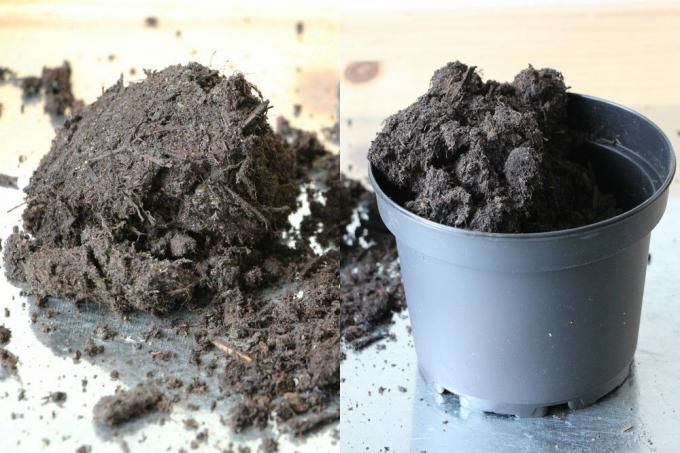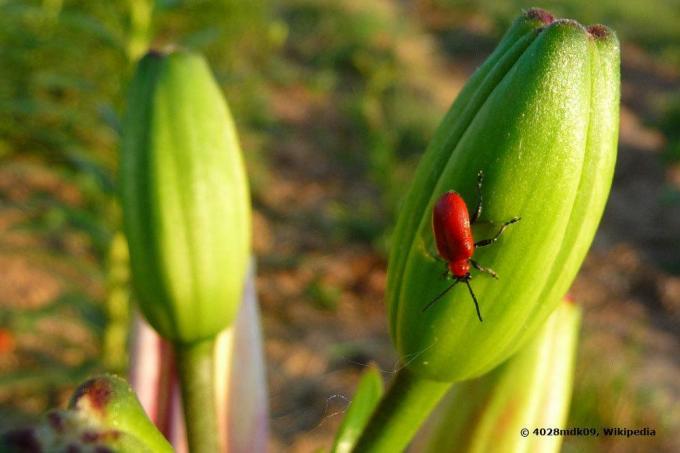
table of contents
- Little animals
- cause
- Sciarid gnat larvae
- Lily chicken larvae
- Springtails
- Root mites
If small white animals / beetles have nested in potting soil, early control is usually required. However, in order to assess this, you should know what species they are so that you can make the right decision. The plant expert illuminates everything worth knowing about the topic and shows control measures.
Little animals
Small white animals / beetles in the potting soil - what to do?
In the flowerbed soil, small white animals or beetles are usually only discovered when digging up. They are usually more noticeable in flower pots. Depending on which beetles / animals they are, they can cause immense damage to plants. Some, on the other hand, pose less of a risk. The plant expert lists various options and describes how effective control can be carried out.
cause
Sciarid gnat larvae
Sciarid gnats are widespread and mainly attack various types of vegetables and mushrooms, but also numerous ornamental plants in greenhouses and in the field. Their larvae are small, caterpillar-like animals that stay in potting soil. They prefer very moist soil, which is why waterlogging should be avoided.

Introduction
The black fungus gnats buzz around the plants, but their main domicile is in the potting soil, where they also lay their eggs, from which small white larvae later develop. So if you suspect sciarid fly larvae, adult flying animals are usually always active in the immediate vicinity. Another possibility is to bring in new potting soil or larvae that are already on the roots when replanting, preferably on cuttings or young plants. They bite into the roots and stems and migrate into the new soil even with a repot.
Damage image
The sciarid fly larvae are carriers of fungi, pathogens and mites. But primarily they damage the roots, which in turn leads to typical and visible symptoms of disease on the plant.
- Growth restrictions
- Buds do not open and increasingly fall off
- Leaves wither
- Plant dries up and eventually dies

Combat
Control only makes sense in the early stages, because if the roots are already too badly damaged, it is usually too late and the plant can no longer be saved. Special insecticides and effective home remedies are available as control measures.
insecticides
So-called yellow stickers help against sciarid fly larvae. These are put into the potting soil. Both the adult fungus gnats and their larvae stick to them because they are covered with a special adhesive layer. If the yellow sticker is full, it will be exchanged for a new one if necessary.

Home remedies
The simplest method is to clean the roots and replace the potting soil. However, this is usually only shown as an effective control measure in the case of a low infestation. To do this, dig up the plant and rinse the roots with strong water pressure. Then let the water drain and pot the plant in fresh potting soil. Tobacco helps with a larger infestation. Work this into the potting soil and water generously every day. After about seven days, the mosquitoes are gone and the larvae have died.

Nematodes
Natural control takes place with nematodes, which are small roundworms. They are harmless to humans and, among other things, feed on the sciarid fly larvae. However, this method is only suitable if you have not yet discovered any adult mosquitoes and the larvae have been introduced with the potting soil or the plant.
Lily chicken larvae
Lily chickens are small beetles that can be recognized by their black head, bright red upper body and wing covers and their size between six and eight millimeters. If these are circling around plants, it doesn't take long for their white larvae to wreak havoc in the potting soil. They mainly attack lilies, checkerboard flowers and even chives. The reproduction takes place two to three times a year between April and June and in September on plants that serve as a source of food. Up to 350 eggs can grow into larvae per laying, which requires rapid control.

Introduction
As with the sciarid fly larvae, the larvae of the lily-chickens can also be introduced through mostly poor-quality potting soil or these beetles are in the immediate vicinity and the larvae in the potting soil are the end product of their reproduction process. In many cases, however, the mother animals also choose unplanted soil. In the case of planting, they are mostly limited to plants that they eat as a source of food, like the plant examples already mentioned.
Damage image
The damage that these larvae can cause is immense for most plant species. They are very voracious and change their white color to dark red on the way to the leaf food source in order to remain as undetected by predators as possible. They stay there and draw all energy out of the tissue from the leaves. They die and fall off. When all the leaves are worn, they use the stems until the plant has dried off completely and dies. Since they are only active during the day, they simply drop back into the potting soil towards evening.

Combat
In order to ensure that it is effective quickly, so that the damage can be kept as low as possible, control with insecticides such as pest-free Parexan or Spruzit in is recommended Liquid form. Alternatively, you can make a solution and use it to treat the infected plant. To do this, proceed as follows.
- Dissolve 30 grams of soft soap in one liter of water
- Add two teaspoons of ethanol or, alternatively, organic alcohol
- Pour the solution into a spray bottle
- Spray all the leaves dripping wet with it every day
- later in the evening, water / spray the potting soil with the solution
- By the third day at the latest, all animals should have died
- Collect dead animals or repot plants in fresh soil
Springtails
One of the most common parasites are the so-called springtails. The white animals can be recognized primarily by their jumping ability, which is reminiscent of fleas and is made possible by two jumping forks that can be seen on their hind legs. They jump around wildly, especially when watering.

Occurrence
They are less brought in by poor-quality potting soil when repotting or planting. They are more likely to be attracted to potting soil that is too moist and highly compacted and multiply in this quickly if they are not stopped.
Damage image
As a rule, springtails do not cause any damage to plants, as they prefer dead, dead plant parts as food. However, if these are all used up and there are no new sources of food in the vicinity the springtails can occasionally be the green of young plants as well as soft, thin root tips eat up. This results in only manageable damage to the plants, but they still reduce the appearance due to the eaten leaves and the reduced number of flowers.

Combat
Usually it is sufficient to put the infected plant in a pot filled with water for about 30 minutes so that the surface of the earth is completely submerged. The animals then automatically reach the surface of the water and can be poured off. So that no new infestation follows immediately, watering should be avoided until the potting soil has dried well.
Root mites
If small white animals are noticeable in the potting soil, it could also be mites, whereby the so-called root mites are the most common. They are in the potting soil, where they are both in depth and on the surface of the earth. They are very small and usually only recognizable as tiny dots. Their habitat extends over roots, bulbs and tubers as well as other parts of plants that lie in the ground and serve them as food, such as dead things. Vegetable plants such as potatoes and carrots, but also ornamental plants such as irises or freesias, are preferably infested.

Introduction
Mites of any kind also often get into apartments and houses through poor potting soil. They are attracted when there is high humidity. The main season for root mites is in the warmer months, although in winter they usually move into warm rooms before the cold.
Damage image
The root mites usually only cause greater damage when they appear in large numbers. Unfortunately, this is not uncommon because they multiply rapidly. Sooner or later, they feed on the roots, which can cause the greatest damage, which shows up as follows.
- decreasing plant stability
- drooping leaves and flowers
- Bud growth decreases
- Leaves turn yellow
- Parts of the plant gradually dry off
- Combat

Unlike many other small, white animals or beetles, repotting is usually not enough. These mites are too small to be removed from the subterranean plant parts this way could be removed, although a root rinse would be helpful in the case of a slight infestation can.
insecticides
For example, the manufacturer Dr. Staehler offers Kiron Mitben-Ex as an insecticide that targets mites. When used on edible plants such as herbs or vegetables, the product proves to be suitable under certain conditions. Mites preparations are called acaricides.
Home remedies
A treatment with wormwood tea is particularly effective and also very environmentally friendly and harmless. This can be bought as a finished product or the tea mixture, which then only needs to be brewed in hot water. The wormwood tea is used in the cold state and used for pouring for about three days. After that, the root mite problem should be over.

Conclusion
If small white animals / beetles are discovered in the potting soil, it is most likely a species as described in this guide. With the right control, you can easily get rid of the unpleasant guests and do not necessarily have to resort to substances that are harmful to health and the environment. However, it is important that you regularly check your plants for animals and beetles, because in most cases they multiply rapidly and plants can be dangerous. However, since they are often difficult to recognize or not even noticeable at first, monitoring is essential.



